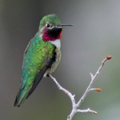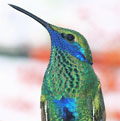Humming
 Broad-tailed Hummingbird Selasphorus platycercusCredit: Desert Vu(Size: 48.61 kb) |
At times difficult to see in their habitats, hummingbirds are sometimes heard before being seen. The most characteristic sound is that produced by their wings, resulting from the friction of air through their feathers. It is the "hmmm" sound they produce that inspired the name hummingbird. The wing trills of some species allow them to be differentiated from one another. The most melodious of hummingbirds is the male Broad-tailed Hummingbird (Selasphorus platycercus).
Grating
The vocalizations of hummingbirds tend to be unpleasant to the human ear; however, they sometimes last only half a second. Given their tiny size, they can be heard only over short distances. |
|
It is rare for a hummingbird to emit a sound that can be heard more than 100 metres away, except for a few species such as the Saw-billed Hermit (Ramphodon naevius). Some of them are inaudible to humans, like the Black Jacobin (Florisuga fusca) whose sounds are at the ultrasound level.
Sounding the alert
Hummingbirds emit different types of calls. The call of pursuit, a series of rather aggressive, rapidly emitted sounds, may be heard from a number of species when defending their feeding territory. These vigorous signals, specific to each species, sometimes help in their identification.
Songs
Some species also emit a longer, more melodious sound. For example, the White-throated Hummingbird (Atthis ellioti) and the Vervain Hummingbird (Mellisuga minima) have a musically sophisticated whistling sound that lasts nearly 30 seconds. The attractive warbling of the Wedge-tailed Sabrewing (Campylopterus curvipennis) of Central America earned it the local name of "nightingale." Finally, the song of the Hermits in the Threnetes genus is also known for its melodious warbling, although it is interspersed with more grating notes.
Long-winded
 Sparkling Violet-ear Colibri coruscansCredit: MrClean1982(Size: 357.52 kb) |
Some species of Hermits in the Phaethornis genus and other Trochilinae of the Colibri genus are among the most persistent daytime singers of all the hummingbirds, presenting their vocal repertoire from morning to night non-stop or almost. However, they remain silent in the moulting period as is the case for most hummingbirds. The male Sparkling Violet-ear (Colibri coruscans), for example, spends close to 70% of its daily activity singing. |

